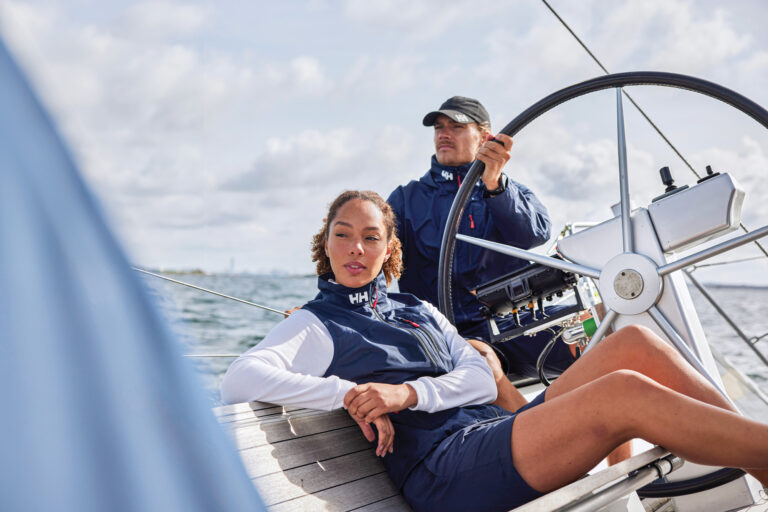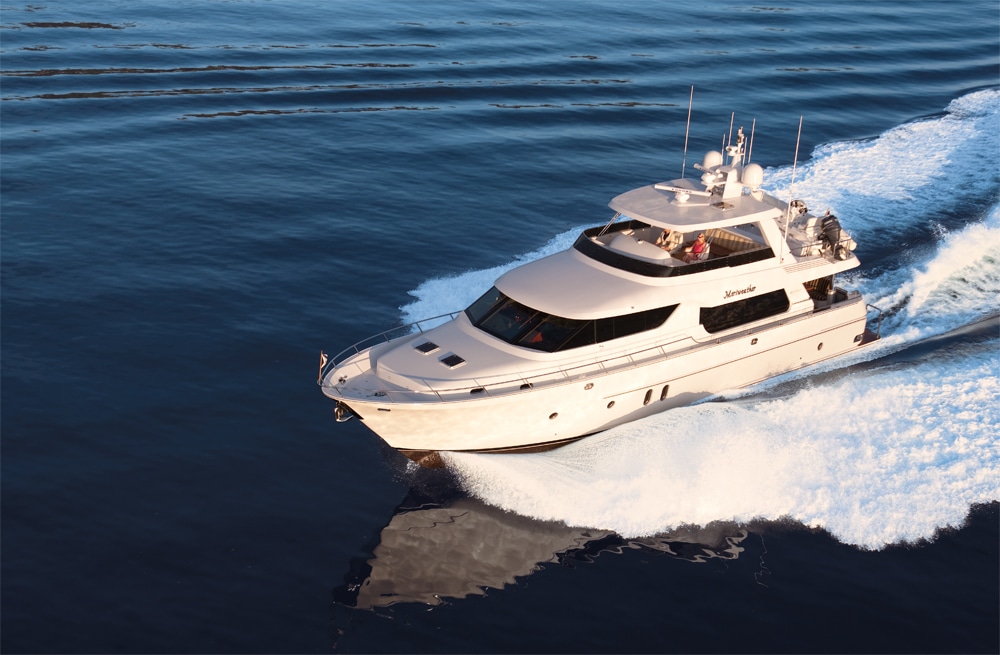
Queenship 74
Funny how quickly an entire segment of an industry can change dramatically over a relatively short period of time. In the early 1990s, yachts in the 70- to 100-foot range were rare enough to raise plenty of eyebrows, and they were overwhelmingly custom-built. These days, their numbers total in the hundreds, and nearly all are production-built.
Except at Queenship. “It’s fun for us — it’s not building the same boat over and over,” explains Lee Taubeneck, president and CEO of Worldspan Marine, Queenship’s parent company. It may take longer and therefore limit production to customize each launch, but Queenship sits confidently within the niche it has carved out for itself.
The owners of Meriweather are also sitting — and cruising — confidently. The 73-foot-10-inch yacht they commissioned from Queenship certainly reflects a lot of their input. Equally important, she embraces a build philosophy that’s uncommon among yachts smaller than 100 feet.
Even the way Meriweather ended up being commissioned is uncommon. According to Taubeneck, the owners had planned to order a West Bay 68 a few years ago, but not surprisingly they changed their minds when that yard filed for bankruptcy. Their broker, Jerry Todd, had known Taubeneck for several years and had reached out to him to see if Queenship had anything suitable. Taubeneck recommended the Gregory Marshall-designed hull form that had been incorporated on 29 deliveries to that point, and explained that the owners’ input into the design was welcome.
Now, several yards build to order, but how many are willing to adapt their normal construction method? In this case, Queenship did. The British Columbia-based yard ordinarily employs vacuum-bagged, foam-cored hulls, but the owners expressed a preference for a solid-fiberglass hull, since it made them feel more comfortable. Queenship agreed to build it.
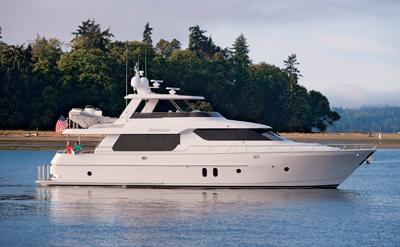
The owners had a handful of other specific ideas in mind based on how they had cruised over the years. Because the husband and wife are owner-operators of this 25-knot-top-speed yacht, there are flip-down control stations to each side on the aft deck. They also frequently cruise their home environs of the Pacific Northwest, where the deep water close to shore makes it customary to toss the anchor near land and back up to it. A self-contained, selfdraining compartment in the center of the lazarette holds 300 feet of 3/8-inch stern line on a stainless steel reel. There’s a crank as well, so the owners can take up any slack. Queenship made the reel, as well as all other stainless steel work on board, in-house. There are particularly good examples of the owners’ experience being paired with that of Queenship when it comes to accessibility of systems. In the engine room, there’s four-sided access to the twin 1,000-horsepower Caterpillar C18s, which are also lit from beneath by blue LEDs. Granted, you need to watch your step outboard of the engines, since the steering cooler line is on the starboard side and the hydraulic tank is accompanied by other runs on the port side. But still, everything is accessible, and some yachts 10 to 30 feet larger than Meriweather permit less access to equipment. And in recognition that an engine room can get pretty hot pretty quickly, Queenship custom-made an intake hood to port. Taubeneck says it circulates cool air better, preventing the opposite-side air exhaust from sucking out the incoming air.
Another good setup: access to the head system and piping, located beneath the stairs to the forward guest stateroom. The stairs lift easily to reveal a space that is Awlgripped, well-lit and ventilated. In a nod to safety, Queenship made sure the stairs self-lower when they’re being put back in place.
The owners and Queenship placed an equally strong focus on aesthetic touches as well. There are plenty of niceties, like sapele mahogany throughout each room, even adorning the appliances in the galley. The salon is its own room too, not a shared space with the dining area, as per the owners’ directive. This type of closed-off layout aboard a yacht of Meriweather’s overall length, compounded by the dark tone of the wood, could easily make a room feel constricted. However, it works well here. Part of the credit goes to the voluminous headroom, a little more than seven feet. It’s also partly due to a bookcase serving as the forward bulkhead. Another solution to an aesthetic problem: A grain-matched, wood-lined cabinet door conceals the wine locker opposite the galley, because the owners didn’t want to see the bottles every time they walked into the room. They even had a specific height in mind when it came to the cathedrals, aka the grain patterns, in the wood veneers used throughout the 74.
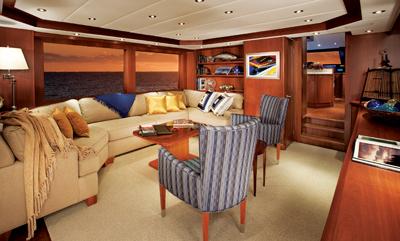
It’s often said that the difference is in the details — and there are certainly details in the lovely, curved crown molding above both the forward guest and master berths. Take a close-up look at both moldings, and you won’t find a seam anywhere. That’s because each is one solid piece, shaped in a steam box that Queenship devised for this very application. (It also helps that Taubeneck, the proud son of a builder of wooden boats, finds seams unacceptable.) The steam box was also put to good use for the curves in the handrail leading from the main deck down to the staterooms. While that handrail is not one solid piece, it may as well be, because the seams of the “hundreds of layers” of mahogany that Taubeneck says were pressed together to form it are barely perceptible.
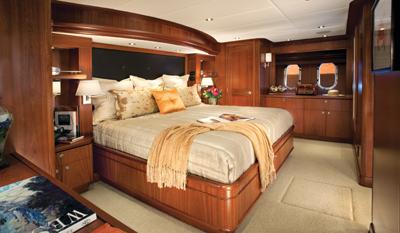
Speaking of perceptible, Taubeneck and the Queenship team were quite concerned about the appearance of the grip strips on the wood steps leading to the flying bridge from the galley/dining area. Taubeneck says the yard tried a variety of different surfaces “to see what looked classy,” but not a lot did. Ultimately, the team decided to machine down the strips that provided good grip.
Still on the subject of those steps, it’s interesting to note that the owners not only wanted a solid staircase, versus a traditional floating one, but also wished the steps to curve. Taubeneck points out that a longer length makes curvature possible — to try to replicate it on this 74-footer would have eaten up needed floor space. Even so, he figured there had to be a way to work out a partial solution. Ultimately, Taubeneck and the craftsmen decided the bottom two steps could curve out slightly to give the owners the flare they wanted.
Queenship also found a solution to a common problem. If you’ve taken note of the pilothouse door hinges aboard some yachts in this size range, you may have noticed they’re bulky. No one doubts their sturdy intent, but as Taubeneck explains, they tend to stick out and interfere when someone is trying to enter or exit the area. Queenship therefore designed and manufactured its own lower-profile stainless steel hinges for the pantographic pilothouse door aboard Meriweather.
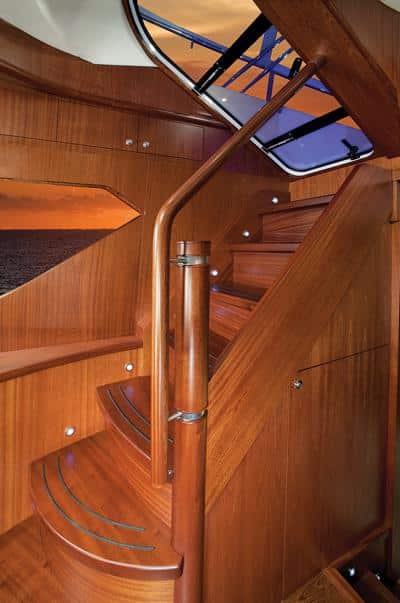
Queenship also gave the owners an impressive amount of stowage. Taubeneck isn’t exaggerating when he says there’s “no wasted space; every little cubby hole was put into storage.” In the pilothouse, there’s a dedicated cabinet to port for a printer. The door opens to reveal a shelf, which in turn lifts up and pulls out into the room for access to printed documents. The wine cooler opposite the galley occupies what would have been wasted space beneath the stairs, since the owners preferred a solid-looking staircase over a floating one. Within the galley, there’s a small area between the wood-veneercovered refrigerator and the stove. Aboard most yachts, this is typically just unused space, covered with wood or whatever surface lines the rest of the cabinets and appliances. Aboard Meriweather, however, it’s home to a skinny drawer and equally skinny cabinet. The drawer can contain items like skewers, and the cabinet is ideal for storing cookie sheets or similarly long, narrow items.
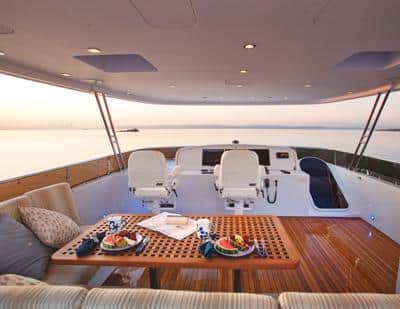
Queenship may represent an anomaly in the yachting industry — a yard that employs custom construction in a mini-megayacht size — but it’s a distinction worn with pride. Where other builders see only problems with predictability and production time, Queenship sees promise. In fact, besides offering a 70-foot pilothouse motoryacht, it’s presently working with another client on an 80-foot yacht-fisherman.
No wonder Taubeneck and his team are having so much fun.
LOA: 73’10”
Beam: 18’10”
Draft: 5’7″
Displ.: 114,000 lb.
Fuel: 1,850 gal.
Water: 380 gal.
Engines: 2 x 1,015-hp Caterpillar C18 ACERT diesels
Base Price: N/A(varies according to owner’s specifications)
Queenship, 604-462-1388; www.queenship.com






